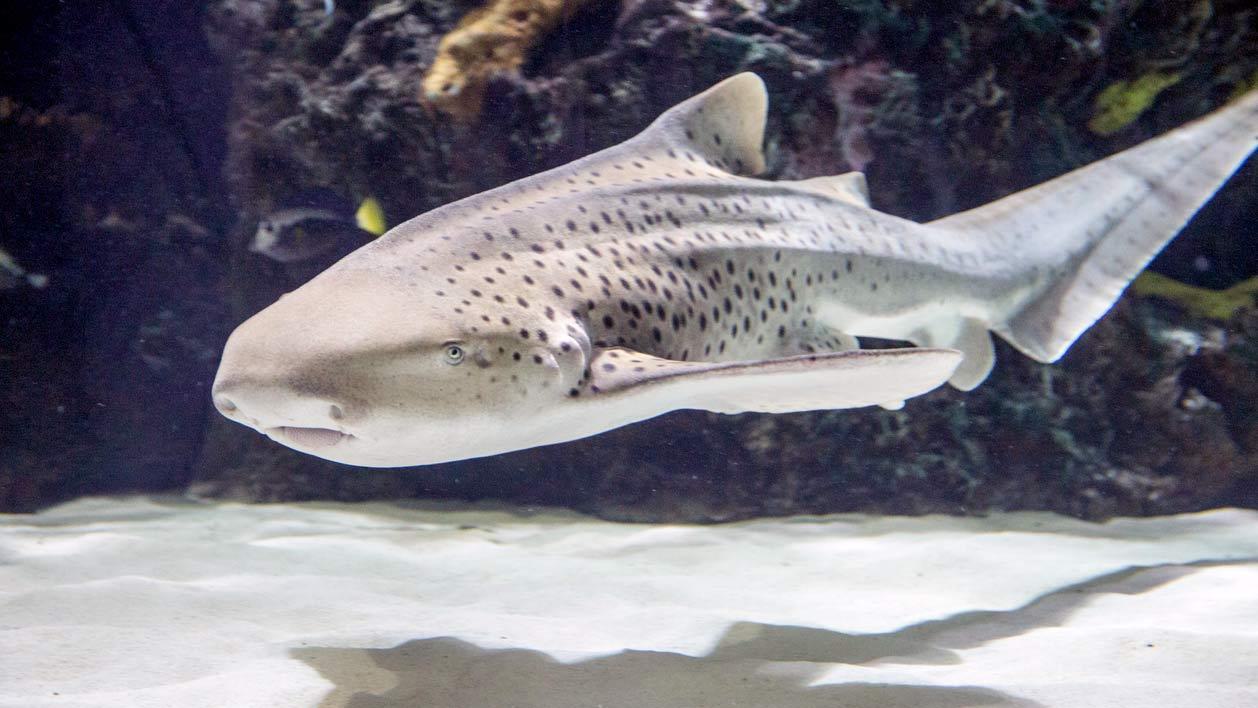Species Name: Stegostoma tigrinum
Zebra sharks are a docile and slow-moving species, and generally not dangerous to humans. They are a species of carpet shark and the sole member of the Stegostomatidae family.

Species Name: Stegostoma tigrinum
Zebra sharks are a docile and slow-moving species, and generally not dangerous to humans. They are a species of carpet shark and the sole member of the Stegostomatidae family.
Approximately 25-30 years.
Small fish and bottom-dwelling animals such as shrimp, snails, crabs, and sea urchins.
Warm, shallow waters in and among coral reefs and sandy flats.
Tropical waters around the Indo-Pacific.
Length: Up to 12 feet
Weight: 45-65 pounds
Zebra sharks are referred to as such because pups are born dark brown with yellowish stripes. As they mature, their bodies lighten to a tan color and the stripes are replaced with small black dots. A zebra shark pup may be less than one foot long at birth, though they can reach up to 12 feet in length as adults, with the tail being half of its total length.
Zebra Or Leopard?
Although they are referred to as zebra sharks in the United States, in Australia, this species is referred to as leopard sharks thanks to their spots as adults. Since there is another shark called the leopard shark (Triakis semifasciata) that lives along the coast of California, this illustrates the importance of scientific naming conventions, in which scientists use Latin genus and species names to refer to a species, rather than common colloquial names.
Diet
Zebra sharks are nocturnal, foraging predominantly at night for small fish, snails, sea urchins, crabs, and other small invertebrates. They use their cat-like whiskers called "barbels" on the end of their snout to help them detect prey. During the day they are usually found resting on the sea floor.
Habitat
They live in shallow tropical water and coral reefs where they can find food hiding in crevices and caves. Their range is broad across the tropical waters in South Asia, Southeast Asia, and Oceania, including areas near Madagascar, Maldives, India, Indonesia, Philippines, Palau, Taiwan, Japan, New Caledonia, Tonga, and Australia.
Respiration
Many sharks generally need to keep moving so water will flow over their gills and provide oxygen to their blood stream, a process known as ram ventilation. However, zebra sharks are capable of buccal pumping, where they can pull or pump water over their gills to receive the oxygen they need. They will also rest facing the current so they can more efficiently pump water over their gills while remaining still. During the daytime hours, zebra sharks can be found resting on the ocean floor and are more active at night when they hunt for food.
Reproductive Behavior
Zebra sharks are "oviparous," and since there is no distinct mating season, they can breed year-round. However, individuals tend to lay eggs within a 112-day period, laying only 3-4 at a time. Their eggs, commonly referred to as "mermaid purses," are anchored to underwater structures or the seafloor until the embryo fully develops and the pup hatches - usually in about 160 days.
Happy Surprise
A zebra shark at an aquarium in Australia once produced viable offspring without ever having been with a sexually mature male. It is assumed this occurred through parthenogenesis, a natural form of asexual reproduction in which the growth and development of embryos occur without fertilization by sperm. Though common in plants, this form of reproduction is very rare in vertebrate animals!
Concerns
While adult zebra sharks are not aggressive and have few natural predators, they are highly susceptible to localized depletion due to their shallow habitat and the degradation of coral reef habitats where they feed. As with other sharks, the most severe threat to this species is humans. Zebra sharks are prized for their meat, which is sold in markets, both fresh and dried, throughout Southeast Asia.
Celebrations
While the zebra shark is considered endangered by the IUCN Red List, in Australia the species is considered Least Concern as it is thriving in waters in that region.
The Virginia Aquarium has partnered with other conservation groups in efforts to protect zebra shark populations through vital breeding programs. You can learn more about these efforts at our Conservation page.

Mena
Mena lives in our Red Sea Aquarium, and can be found either swimming overhead or resting on the sand on either side of the tunnel.

Endangered (EN)
A taxon is Endangered (EN) when the best available evidence indicates that it meets any of the criteria A to E for Endangered, and it is therefore considered to be facing a very high risk of extinction in the wild.
IUCN Red List